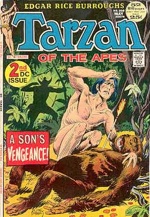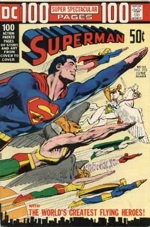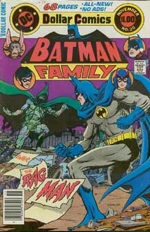Comics /
Cult Favorite
Basic Instructions: How to Shop for Back Issues
By Philip Schweier
July 30, 2009 - 17:37
Recently while poking through back issue bins in a comic book store, Mrs. Wife asked me how I structured my buying budget. Did I just try to get the most number of books for the least number of dollars, or did I have a different system altogether?
I used to do it that way, but such bargain hunting often lead to frustrating searches through various dealers at conventions, and disappointment when I couldn't remember who it was that had that single issue of DC Comics'
Tarzan title that I needed.
It also led to conspicuous gaps in my collection; isolated issues that prevented me from having a complete run from issue #A to issue #B. I am by nature a bit anal retentive, and I absolutely abhor loose ends. Missing one issue out of 40 is a source of constant aggravation.
She then asked me about "The List," a stack of pages of comic book titles and issues that I look for to complete my collection. Why do some titles get more attention than others, only to be reversed during a later shopping trip?
Obviously, every collector has his own system for keeping track of what his collection consists of, and what it's missing. So I devised a listing system that helps me avoid my own personal pitfalls, and while it's certainly not the only way, it's what works for me. Feel free to ignore it, or adapt it for your own use.
Obviously, an alpha/numeric list is a pretty good way to start. Mine is in a grid pattern, broken into five columns. The first column features the title of the comic book, with a notation for why I want it (Neal Adams art, Wolverine appearance, that sort of thing). Second column is the issue number. The remaining columns are sources for that issue, with pricing. For instance, how much it costs on ebay, how much at milehighcomics.com, and how much at my favorite comic book store.
Each page has 20 rows, but that's because I like things big and easy to read, including the title of the series, which I list downward along the right-hand side. This makes it easier to find any given page, rather than hunt for it buried beneath the staple, which is customarily in the left top corner.
Each page features one title per page. Instances where I'm looking for more than 20 issues, I just start another page. I also maintain a miscellaneous page for small groups or isolated issues.
For titles where I'm missing large numbers of issues, I keep a chart of numbers broken down into 10 issues per line, 10 lines per page, 100 issues overall. As these issue numbers are filled in, I highlight them, cross them out, or mark them in some fashion to indicate I no longer need them. This chart can also be duplicated in part on each page of the list, illustrating at a glance what issues might be missing from all the issues listed on that page.
As I said, I am a bit anal retentive by nature, appreciating a continuous line of issues in any given title, and conspicuous gaps tend to not sit well with me, especially if it's only an isolated issue or two. This is where I concentrate most of my efforts.
But when I know that I'm in for a shopping spree, be it a trip to my favorite out-of-town store or a convention, I tend to concentrate on buying large blocks of issues, especially newer ones. I can usually pick these up at lower prices, especially if I'm buying in volume.
Let me offer an example. I am currently buying up
Superman issues from #231 (c. 1970) to #425 (c.1985). The later issues I'm missing (roughly #401-414) I've back-burnered until my next convention, in the hopes of finding a dealer who will give me a price break for buying a healthy number of issues.
But #252 is an isolated issue, and much older. It's likely to come at a higher price, if I'm able to find it. That's a judgment call for me to make when the time comes.
Meanwhile, my mid-1970s
Brave and the Bold collection is intermittent. Earlier issues, around the 120s are missing a handful, but the gaps are larger in later issues (the 140s). If I focus on the early issues, I not only close the gaps, but I'm also likely to find them at better prices now rather than later, as the price of old comics continues to climb.
One final page I keep on hand is one that lists whatever issues I'm concentrating on at the moment, in order of priority. The two
Aquaman issues I'm looking for take priority over the four
Batman Family missing from my collection, or the early 1970s
Action Comics gaps I hope to close. I refer to these as "plateaus." By concentrating on closing gaps or completing collections, I reach another plateau, enabling to discard a page or title from The List altogether.
Last Fall I attended a convention using this approach for the first time, and afterwards I was able to discard four pages from the 20-page list. Since then I've knocked The List down to eight pages. It's a very satisfying process for me.
Like I say, it may not suit everybody, but it's open for adaptation. If you're interested in a list like mine, e-mail me. I can send it to you in Quark Xpress or as a PDF. Or if you have any better ideas that work for you, I'd like to hear about those too.
Praise and adulation? Scorn and ridicule? E-mail me at philip@comicbookbin.com
Last Updated: March 3, 2025 - 20:40


